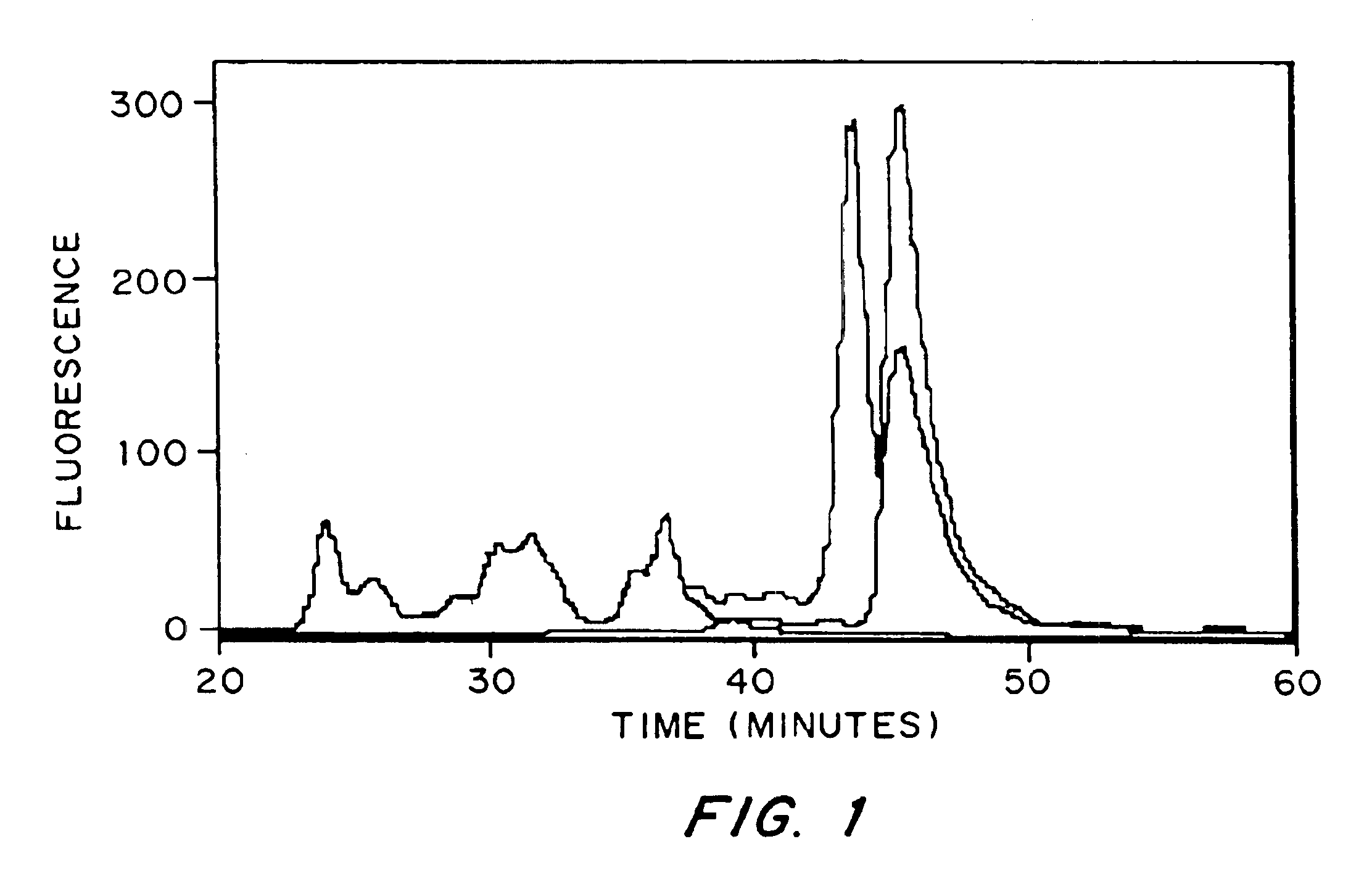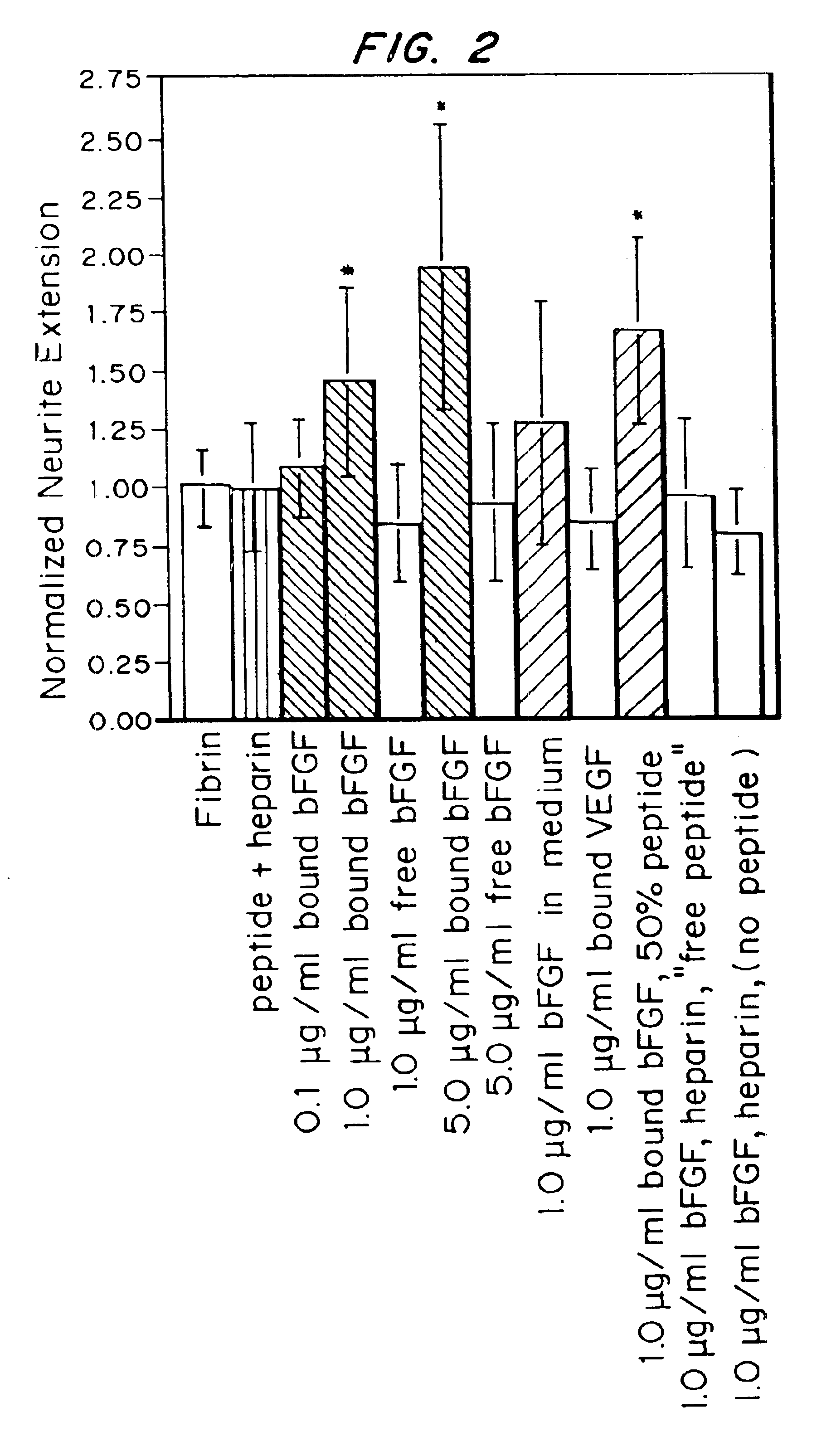Growth factor modified protein matrices for tissue engineering
a technology of growth factor and protein matrices, applied in the field of growth factor modified protein matrices for tissue engineering, can solve the problem of not being able to mimic certain proteins with only short peptides, and achieve the effect of optimizing the ratio or level of growth factor
- Summary
- Abstract
- Description
- Claims
- Application Information
AI Technical Summary
Benefits of technology
Problems solved by technology
Method used
Image
Examples
example 1
Indirect Couple of Heparin via a Heparin-binding Peptide to attach growth factor.
[0075]A peptide chimera containing both a factor XIIIa substrate and a heparin-binding domain was synthesized by standard solid phase synthesis. A sample peptide is one containing the following sequence, dLNQEQVSPK(A)FAKLAARLYRKA (SEQ IN NO:21), where the N-terminus of the peptide contains the factor XIIIa substrate and the sequence in italics contains a modified peptide from the heparin-binding domain of ATIII (dL denotes dansyl leucine, which is used to allow detection of the peptide by fluorescence).
[0076]Size exclusion chromatography was used to determine the amount of peptide cross-linked to fibrin gels using the previously developed incorporation method. A bi-domain peptide containing the heparin-binding domain from antithrombin III and a flourescent label was incorporated into fibrin gels during polymerization. The free peptide was washed from the gels, and the fibrin network was degraded with pl...
example 2
Synthesis of Heparin-Peptide Chimeras
[0092]A heparin-peptide chimera is synthesized by coupling a peptide, containing the factor XIIIa substrate on the N-terminus and a poly-lysine on the C-terminus, to a heparin oligosaccharide, with a unique aldehyde group on one end, via reductive amination. A peptide with the following sequence, dLNQEQVSPLKKKG (SEQ ID NO:22), is synthesized by standard solid phase peptide chemistry. The heparin oligosaccharides are made by standard nitrous acid degradation of heparin, resulting in the formation of an aldehyde on the reducing terminal of the cleaved oligosaccharide. During coupling, the -amino group of the lysine side chain attacks the aldehyde on the reducing end of the heparin oligosaccharide to form a Schiff base. The Schiff base is then reduced to form a stable product. A sample coupling protocol is given below. One can also couple the heparin to the simple alpha 2 plasmin inhibitor substrate site NQEQVSP (SEQ ID NO:20). A primary amine exist...
example 3
Degradable Sites in Fusion Protein and In Peptide Chimera NGF fusion proteins containing Factor XIIIa substrate and a Plasmin degradation site
[0118]β-NGF fusion proteins were expressed with an exogenous cross-liking substrate that allows the β-NGF fusion proteins to be enzymatically cross-linked to fibrin matrices, which served as the base material for the drug delivery system. A plasmin substrate was placed between the cross-linking substrate and the β-NGF domain in the fusion protein, which served as a degradable linker and allowed β-NGF to be released from the matrix in a form almost identical to its native sequence by enzymatic cleavage. The β-NGF fusion proteins were covalently attached to fibrin by the transglutaminase activity of factor XIIIa and were tested in an in vitro model of nerve regeneration to determine the ability of the delivery system to release active growth factors in response to cell-associated enzymatic activity.
[0119]Gene synthesis
[0120]Two β-NGF fusion prot...
PUM
| Property | Measurement | Unit |
|---|---|---|
| volume | aaaaa | aaaaa |
| pH | aaaaa | aaaaa |
| pH | aaaaa | aaaaa |
Abstract
Description
Claims
Application Information
 Login to View More
Login to View More - R&D
- Intellectual Property
- Life Sciences
- Materials
- Tech Scout
- Unparalleled Data Quality
- Higher Quality Content
- 60% Fewer Hallucinations
Browse by: Latest US Patents, China's latest patents, Technical Efficacy Thesaurus, Application Domain, Technology Topic, Popular Technical Reports.
© 2025 PatSnap. All rights reserved.Legal|Privacy policy|Modern Slavery Act Transparency Statement|Sitemap|About US| Contact US: help@patsnap.com



